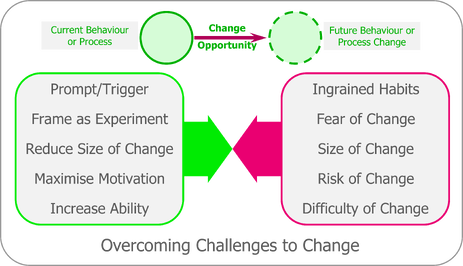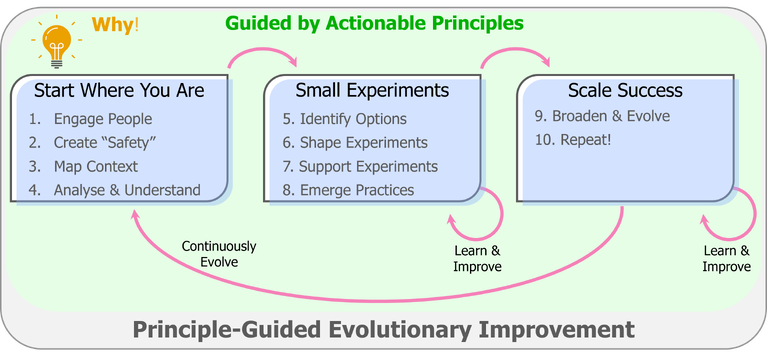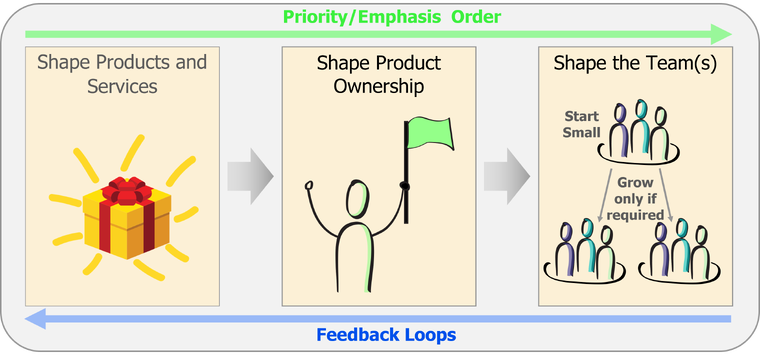The Change Perspective: Difference between revisions
| (2 intermediate revisions by the same user not shown) | |||
| Line 16: | Line 16: | ||
[[File: | [[File:Challenges to Change.png|frameless|463x463px]] | ||
| Line 50: | Line 50: | ||
[[File: | [[File:ELSE Change Journey.png|frameless|767x767px]] | ||
===Why!=== | ===Why!=== | ||
| Line 62: | Line 61: | ||
*[[Create clarity of purpose]] | *[[Create clarity of purpose]] | ||
*[[Maximise engagement]] | *[[Maximise engagement]] | ||
[[File:Start Where You Are - ELSE.png|left|frameless|196x196px]] | |||
When reviewing the root causes of change failures, it is common to find faulty assumptions and incomplete perspectives of how complex work gets done. It is easy to miss many informal networks and relationships and put too much trust in official documentation and organisational charts. | |||
[[File:Start Where You Are.png|left|frameless| | |||
When reviewing the root causes of change failures, it is common to find faulty assumptions and incomplete perspectives of how complex work gets done. It is easy to miss many informal networks and relationships and put too much trust in official documentation and organisational charts. | |||
''We must start changing from where we are, with an honest and critical analysis of the current system of work with a mindset to discover, drill down and address root causes of challenges to value creation.'' | ''We must start changing from where we are, with an honest and critical analysis of the current system of work with a mindset to discover, drill down and address root causes of challenges to value creation.'' | ||
====Engage People==== | ====Engage People==== | ||
| Line 87: | Line 80: | ||
* [[Create clarity of purpose]] | * [[Create clarity of purpose]] | ||
*[[Catalyst for change]] | *[[Catalyst for change]] | ||
====Create Safety==== | ====Create Safety==== | ||
| Line 104: | Line 96: | ||
*[[Create a Learning Organisation]] | *[[Create a Learning Organisation]] | ||
*[[Evolutionary over revolutionary change]] | *[[Evolutionary over revolutionary change]] | ||
====Map Context ==== | ====Map Context ==== | ||
| Line 111: | Line 102: | ||
Structured interactive workshops are an excellent approach to engage and incorporate diverse perspectives into a shared picture of the current context and surface the challenges to be addressed. | Structured interactive workshops are an excellent approach to engage and incorporate diverse perspectives into a shared picture of the current context and surface the challenges to be addressed. | ||
There are many workshop techniques and structures that can be used, Value Stream Mapping is an excellent example. | There are many workshop techniques and structures that can be used, Value Stream Mapping is an excellent example. Whilst deriving ELSE, we evolved an effective Context Mapping Workshop (this will be documented in the Practices section of the wiki), which is another option. | ||
Here are some ideas for workshop options to support the mapping of the current context, digging down to root causes, and assessing the strengths and weaknesses of potential improvement options: | Here are some ideas for workshop options to support the mapping of the current context, digging down to root causes, and assessing the strengths and weaknesses of potential improvement options: | ||
| Line 122: | Line 113: | ||
* 5 Whys | * 5 Whys | ||
*Forcefield Analysis | *Forcefield Analysis | ||
====Analyse & Understand==== | ====Analyse & Understand==== | ||
| Line 133: | Line 123: | ||
The outcome should be a prioritised list of challenges where there are larger deviations from the principles. When prioritising, it is worth considering addressing challenges considering the emphasis shown in the diagram below: | The outcome should be a prioritised list of challenges where there are larger deviations from the principles. When prioritising, it is worth considering addressing challenges considering the emphasis shown in the diagram below: | ||
[[File: | [[File:Improvement Order - ELSE.png|frameless|760x760px]] | ||
| Line 140: | Line 129: | ||
[[File:Small Experiments - ELSE.png|left|frameless|201x201px]] | |||
[[File:Small Experiments.png|left|frameless| | |||
Limiting the scope and framing changes as experiments rather than finalised change decisions reduce fear and risk. Work to reduce the scope of changes so that they impact only a small part of the system’s processes and a manageable subset of people. | Limiting the scope and framing changes as experiments rather than finalised change decisions reduce fear and risk. Work to reduce the scope of changes so that they impact only a small part of the system’s processes and a manageable subset of people. | ||
Start small with the primary objective of maximising learning - validating or invalidating assumptions and risks and gaining empirical data that | Start small with the primary objective of maximising learning - validating or invalidating assumptions and risks and gaining empirical data that enables better planning and decision-making for the next steps. | ||
Supporting Principles: | Supporting Principles: | ||
*[[Scale only when you need to]] | *[[Scale only when you need to]] | ||
| Line 258: | Line 245: | ||
[[File: | [[File:Scale Success - ELSE.png|left|frameless|200x200px]] | ||
Don’t assume the need to scale! | Don’t assume the need to scale! | ||
It may be that we have now validated assumptions, derisked some key risks and provided the basis for understanding how we need to scale up and expand the teams. Alternatively, we are making excellent progress, so scaling is not required. Or, perhaps the “Start Small” approach has quickly and cheaply “Failed”, and the business can now make a better decision and pivot to an alternative strategy. The larger the scale, the more expensive and difficult it is to make the hard call to abandon a bad idea! | It may be that we have now validated assumptions, derisked some key risks and provided the basis for understanding how we need to scale up and expand the teams. Alternatively, we are making excellent progress, so scaling is not required. Or, perhaps the “Start Small” approach has quickly and cheaply “Failed”, and the business can now make a better decision and pivot to an alternative strategy. The larger the scale, the more expensive and difficult it is to make the hard call to abandon a bad idea! | ||
Supporting Principles: | Supporting Principles: | ||
*[[Start small and scale success]] | *[[Start small and scale success]] | ||
Latest revision as of 14:56, 29 January 2024
Adapt or Die!
Like other organisms, organisations must continually reinvent themselves to survive and thrive. With the accelerating pace of change, the ability to rapidly evolve has become an existential necessity.
A fundamental leadership responsibility is to help organisations navigate OODA loops (Observe, Orient, Decide, Act) to learn and adapt continually. Any scaling endeavour will require adaption from current structures, behaviours, systems, processes, policies, etc., to an organisation better equipped to thrive in its environment.
The ability to continually change must become part of an organisation's DNA rather than being treated as a transaction with a beginning and end. It will likely be too late if an organisation waits until an event makes the need for change evident.
So, organisations need to adapt, but in which direction? Simply copying “Best Practice” from other organisations is unlikely to create a competitive advantage, and there is no guarantee that it will suit your unique organisational context and culture. Leadership takes responsibility for catalysing a direction and purpose for change that guides a process of emergent practice.
"It is not the strongest of the species that survives, nor the most intelligent that survives. It is the one that is most adaptable to change." Charles Darwin (1809 - 1882)
Challenges to Change
Changing organisational systems is generally challenging, highly disruptive, risky and takes more time than expected. The larger the change and the greater the cultural shift required, the more this is true.
The diagram above identifies some forces that inhibit change and suggests appropriate strategies to address the challenges - discussed below.
Many personal, group and systemic factors push back against proposed changes:
- Ingrained Habits - Habit creates inertia to change; by default, people will do things the way they always have.
- Fear of Change - Change is complex and uncertain, creating a fear of the learning challenge and potential negative impacts on those involved.
- Size and scope of Change - More dramatic changes and those impacting more people and systems will suffer increased resistance.
- Risk of Change - Some changes have a greater perceived or real risk of high-impact failure.
- Difficulty of Change - The proposed changes may require new or rare skills or immature organisational support capabilities that still need to be implemented.
- Lack of Motivation - The need for change has not been widely established and communicated, or there is insufficient belief and trust in proposed changes.
Evolutionary Change
The “Change Journey” is at least as important as where you arrive. A transactional change from today’s state to a target state misses out on the journey experiences and learnings, which provide time to learn, adapt and acclimatise.
Organisations are complex adaptive systems by nature, and changing them is an unpredictable business, often resulting in unforeseen side effects. Agile approaches have emerged to deal with complex problems, so they are a natural choice to apply to the challenge of change. This section offers an evolutionary and incremental change model, with inspection and adaptation cycles at its heart.
Supporting Principles:
The diagram below outlines a cycle of evolutionary change guided by principles that are abstract enough to be widely applicable but concrete enough to implement. These principles are called Actionable Principles.
Why!
Given the challenges of change, there needs to be clear and agreed reasons to motivate people to risk modifying systems and ways of working. Clarity of purpose will also inform strategies and decisions on the direction and details of the evolving changes. For this reason, “Why!” is shown in the diagram, providing context for the entire change cycle.
At a high level, the need to continually evolve the organisation to stay relevant and viable will likely be a constant but abstract motivator. As we go deeper, more specific and concrete reasons for improvement to systems, processes, policy, etc. will need to be established. These purposes should be formed in collaboration with those involved and impacted by potential changes. See “Engage People” below.
Supporting principles:
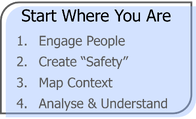
When reviewing the root causes of change failures, it is common to find faulty assumptions and incomplete perspectives of how complex work gets done. It is easy to miss many informal networks and relationships and put too much trust in official documentation and organisational charts.
We must start changing from where we are, with an honest and critical analysis of the current system of work with a mindset to discover, drill down and address root causes of challenges to value creation.
Engage People
Involve those affected by change in exploring the current systems and processes and identifying opportunities to improve them. This strategy will lead to better-informed change with buy-in and increased motivation from those who will enact the improved processes.
Many change programmes meet significant resistance from those impacted by the change. One of the reasons for this resistance is that the change is forced on them, and they need more understanding of the reasons driving the change. Establishing the “Why” through collaborative engagement with those impacted by change can shift their place in the change process from victims to supporters.
Process changes are often designed based on flawed assumptions about current processes. Involving those with intimate knowledge of systems and processes impacted by change leads to better-informed decision-making. This, in turn, increases trust and helps reduce resistance to change.
Supporting principles:
- Involve those affected by change
- Shared context improves decisions
- Maximise engagement
- Create clarity of purpose
- Catalyst for change
Create Safety
Amy Edmondson defines Psychological Safety as ”a belief that one will not be punished or humiliated for speaking up with ideas, questions, concerns or mistakes…”
It seems such a simple statement, but without Psychological Safety, nothing good happens: errors and issues remain hidden, and learning and improvement are stunted. With high levels of Psychological Safety, we open the door for greater engagement and innovation, improved work quality and collaboration, and support for learning and process improvement.
Establishing a safe environment is a priority for leadership to ensure that less bravery is required to identify and explore current challenges down to their root causes. A reduction in the fear of failure will enable experiments to safely explore innovative solutions and identify and apply learnings.
Supporting principles:
- Create the environment for people to thrive
- Foster a high trust environment
- Involve those affected by change
- Maximise engagement
- Create a Learning Organisation
- Evolutionary over revolutionary change
Map Context
The aim of this step is to establish a shared understanding of the current context by engaging all relevant stakeholders and sources of data in a rapid, collaborative process. Avoid getting bogged down in over-analysis and ensure that all stakeholders appreciate that this is an emergent process.
Structured interactive workshops are an excellent approach to engage and incorporate diverse perspectives into a shared picture of the current context and surface the challenges to be addressed.
There are many workshop techniques and structures that can be used, Value Stream Mapping is an excellent example. Whilst deriving ELSE, we evolved an effective Context Mapping Workshop (this will be documented in the Practices section of the wiki), which is another option.
Here are some ideas for workshop options to support the mapping of the current context, digging down to root causes, and assessing the strengths and weaknesses of potential improvement options:
- Value Stream Mapping
- Impact Mapping
- Wardley Mapping
- Causal Loop Diagramming
- Fishbone Analysis
- 5 Whys
- Forcefield Analysis
Analyse & Understand
With a comprehensive map and understanding of the current context, inspect with common sense and the Scaling Principles as lenses. Identify where there are larger gaps between the principles and reality, pointing to opportunities for improvement.
The mapping exercise often reveals challenges that are not immediately apparent, due to the collective diverse perspectives of stakeholders. Others require the application of the principles to be revealed as their impacts may be harder to spot or pin down the causes.
Use the Scaling Principles to inspect the map(s) and explore how the current context supports each principle. A useful workshop technique is to divide stakeholders into small groups, each applying a subset of the principles for a time-boxed period before rotating to another subset.
The outcome should be a prioritised list of challenges where there are larger deviations from the principles. When prioritising, it is worth considering addressing challenges considering the emphasis shown in the diagram below:
We see many instances where team structure and communication patterns are optimised within a poor product structure and product ownership that reduces their alignment with value creation. So whilst tactical improvements can be accomplished at a team level, greater progress may require starting with improvements to the structure of products and services before addressing product ownership and teams.
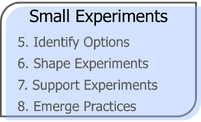
Limiting the scope and framing changes as experiments rather than finalised change decisions reduce fear and risk. Work to reduce the scope of changes so that they impact only a small part of the system’s processes and a manageable subset of people.
Start small with the primary objective of maximising learning - validating or invalidating assumptions and risks and gaining empirical data that enables better planning and decision-making for the next steps.
Supporting Principles:
Identify Options
Building on the context mapping and analysis, engage stakeholders to generate multiple diverse options for improvement experiments.
Don’t assume the need to scale! Consider that you might not need to scale at all: a highly productive team working in a supportive environment might be everything you need to create great products. Scaling always adds complexity and process wastes, so prioritise options that improve at the current scale before resorting to scaling.
Consider “De-scaling”. If improving an already scaled system, then explore options that enable the scaling level and complexity to be reduced. A surprising amount of performance improvement can often be unlocked by reducing complexity and overhead.
Options can be assessed and prioritised by many factors, including their envisaged relative:
- Positive impact
- Financial cost
- Effort
- Availability of required skills or capability
- Risk and blast radius
- Resistance
- Elapsed time to feedback and learning
Generate a shortlist of the most promising options to take forward and shape as experiments.
Supporting Principles:
- Involve those affected by change
- Scale only when you need to
- Start small and scale success
- Minimise unnecessary complexity
- Are lean practitioners
Shape Experiments
Intentionally frame potential changes as “Experiments” to ensure that we admit that we don’t know everything and the outcome is not certain, with “Failure” a likely option. Make it “Safe to Fail” by reframing “Failure” as an unexpected outcome of the experiment that provides an opportunity to learn. The learning can then be incorporated into improved or illuminate better alternative change options. This strategy reduces the traditional stigma of failure that creates a fear of innovating and changing the way things have always been done.
Collaboratively develop a hypothesis for an experiment to address an option for improvement. A change experiment hypothesis may include the following elements:
- The “Why” - context of the challenge to the Scaling principles.
- The outcome we hope to see.
- Experiment plan outline
- When - how long we expect to run the experiment and observe results.
- Who - people involved and impacted.
- What changes - structure, systems, processes, policies, skills, roles, etc.
- Validation - how we will assess outcome progress and success.
- Key assumptions, challenges and risks.
- Support required.
Shape small experiments, or as Jason Little refers to them: MVCs - Minimum Viable Changes. When considering what changes - keep impact and effort low by making local and/or temporary changes or exceptions to normal working practices for the experiment timebox. If the experiment validates changing more officially and widely, then see Scale Success, below.
Prompts and Triggers
Even with great motivation to change, there is the inertia of ingrained habits to overcome. To help tackle this challenge to change, we need to provide some scaffolding to support new behaviours. An effective pattern is to either modify or insert prompts into existing processes and systems to trigger new behaviours. For example, a change might be as simple as adding a new column to a Kanban board or inserting a question into a planning meeting agenda.
In addition, address any shortcomings in the skills and capabilities of people and systems in order to reduce the challenge of the new behaviours. If a change is too difficult, people will be far less likely to follow through.
Parallel Experiments to Speed Learning
Running parallel experiments can enable more learning in a given period of time. However, there are some caveats:
- The experiments must be able to run independently without impacting each other and this might be difficult to predict. It must be possible to attribute observed outcomes to a specific experiment and avoid the possibility of one cancelling the benefits of another.
- Ensure that the additional WIP due to initiating, supporting and learning from the experiments does not negatively impact the outcomes of the process. Taking on too many parallel changes can overload the capacity to support the experiments and may lead to incorrect invalidation of good ideas that lack sufficient support.
Supporting Principles:
- Involve those affected by change
- Foster a high trust environment
- Provide an impediment removal service
- Catalyst for change
- Create clarity of purpose
Support Experiments
Seek volunteers to run and support experiments to reduce resistance and provide the motivation to give the idea a fair trial.
Those in a leadership or influential positions can support experiments in the following ways:
- Retain and remind all involved as to the purpose to keep aligned on the “Why”.
- Provide air cover to enable bending or breaking of normal rules within the context of the experiment.
- Help understand and mitigate or resolve impediments.
- Support a “Safe to Fail” culture by ensuring that responses to unexpected outcomes of experiments are constructive and lead to learning and adaptation.
When it comes to cultivating a Safe to Fail culture, asking questions like "What can we learn from this outcome?" helps foster open and honest discussions that are free from blame. In contrast, questions like "Who thought this was a good idea?" can be thoroughly counterproductive. Unexpected outcomes often present the greatest opportunities for learning, as they can help us uncover faulty assumptions and gain new insights.
It is vital that the outcomes, whether intended or unintended, are investigated down to root causes to ensure depth learning.
Supporting Principles:
- Foster a high trust environment
- Provide an impediment removal service
- Catalyst for change
- Create clarity of purpose
Emerge Practices
Whilst practices and patterns harvested from external sources such as scale frameworks are useful input, they should be adapted to fit the specific context. Practices are then “Emerged” through a process of evaluating, learning and further adaptions based on the outcomes of small experiments.
True innovative change often emerges from the serendipitous and accidental discovery of practices and patterns that provide both intended and unintended benefits and improvements. Of course, the reverse can also occur, with unintended and unforeseen negative side-effects resulting from an experiment.
Intentionally and regularly assess the results of experiments to understand the desirable and undesirable consequences arising. Analyse whether the consequences point to alternative purposes that were not originally envisaged i.e. intentionally repurpose existing and emergent capabilities for reasons that are different to the original intent. Dave Snowden refers to this process as Exaptation.
Actively look for and experiment with removing practices whose purpose appears to have become redundant but have been retained through force of habit.
Culture Impact
Be aware of the cultural impact of experiments. It is important to understand the difference and relationship between making changes to the environment versus the behaviour changes caused by the environment.
“Environmental factors, which often seem benign or inconsequential, play powerful roles in shaping our behaviors.” - The Good Samaritan Study ("From Jerusalem to Jericho"). As changes are made to the working environment and its associated systems and processes, they will impact how people behave and think. This is clearly an essential element of the feedback loop into the process of emerging practice and cultural change.

Don’t assume the need to scale!
It may be that we have now validated assumptions, derisked some key risks and provided the basis for understanding how we need to scale up and expand the teams. Alternatively, we are making excellent progress, so scaling is not required. Or, perhaps the “Start Small” approach has quickly and cheaply “Failed”, and the business can now make a better decision and pivot to an alternative strategy. The larger the scale, the more expensive and difficult it is to make the hard call to abandon a bad idea!
Supporting Principles:
Broaden and Evolve
Once experiments have reached a level of maturity where there is good evidence that the changes are positive and practical, then incrementally broaden through engagement with a wider scope and audience.
Scaling success should be done in an incremental and evolutionary style rather than a big-bang rollout! This process should still be “Experimental”, looking to learn and evolve, being considered “Emergent Practice” and definitely not “Best Practice”. Understanding the context of the successful experiment is vital when considering its broader application or incorporation into formal practices.
Seeking volunteers is always preferred over mandating and pushing changes onto unwilling victims! The guidance on engaging those impacted by changes still holds when broadening and evolving practice. Engaging volunteers from the initial experiments to act as supporting coaches for new groups can reduce cognitive load and speed up the evolution of improvements.
Supporting Principles:
- Start small and scale success
- Scale only when you need to
- Evolutionary over revolutionary change
- Involve those affected by change
Repeat!
Improvement is a continuous endeavour and should definitely not be considered a transactional process.
The impact of improvements will change the context, and given the complex adaptive nature of human systems, the outcomes may not be entirely as expected. It is, therefore, essential that we start by re-engaging our people to re-assess the context before embarking on further changes.
Change Perspective Summary
- The ability to continually change must become part of an organisation's DNA rather than being treated as a transaction with a beginning and end.
- Don’t Copy & Paste “Best Practice”
- Organisational change is complex and requires an iterative and incremental evolutionary approach.
- Establish a clarity of purpose at all levels and engage those impacting and impacted by the changes.
- A Psychologically Safe environment will enable challenges, weaknesses, waste and errors to be surfaced and addressed.
- Start from where we are with an honest and critical analysis of the current system of work with a mindset to discover, drill down and address root causes of challenges to value creation.
- Use collective workshops where stakeholders with diverse perspectives map the current context and then analyse and understand it through the lens of Scaling Principles.
- Support workshops with appropriate collaborative mapping techniques.
- Identify and prioritise options for experiments.
- “De-scale” - always consider options for reducing the complexity of the current context!
- Reduce the risk, fear and resistance to change by using small safe-to-fail experiments.
- Shape, support, and incorporate learning from experiments into emergent practices.
- Scaling success should be an evolutionary process.
References
https://en.wikipedia.org/wiki/Complex_adaptive_system
https://en.wikipedia.org/wiki/OODA_loop
Set-based Concurrent Concurrent Engineering
Minimum Viable Changes (MVCs) - Little, Jason. Lean Change Management: Innovative practices for managing organizational change (p. 36).
Darley, J. M., & Batson, C. D. (1973). "From Jerusalem to Jericho": A study of situational and dispositional variables in helping behavior.
Journal of Personality and Social Psychology, 27(1), 100.
